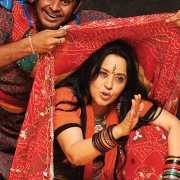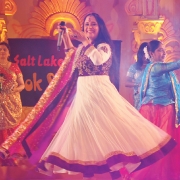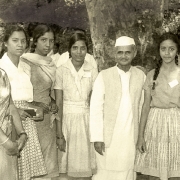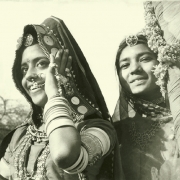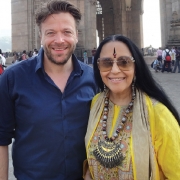
People
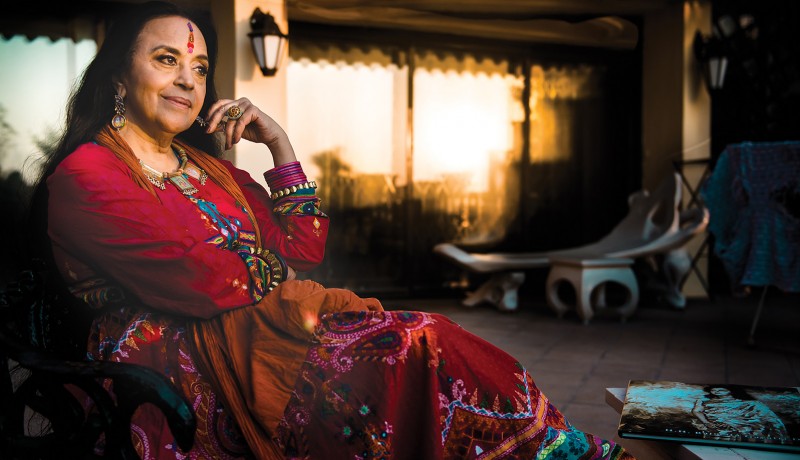
As she prepares to release her new album and open a dream theatre, multitalented artist Ila Arun opens her heart to Sai Prabha Kamath
She gave a modern spin to the jhumka and ghagra, breathing new life into traditional folk songs and giving them a whole new audience. In the process, Ila Arun has become a cultural ambassador of her beloved Rajasthan. “Culture is the strong point of the state and every part of me is a Rajasthani,” she says with humility. “Rajasthan has given me much more than what I have given it.”
Singer, actor, composer, writer, lyricist, folk artist are some of the labels Arun has taken in her stride, preferring to call herself “a theatre artist”. In the 1990s, she grabbed the attention of the world for her uninhibited and sensuous rendition of Choli ke peeche in the film Khalnayak, which bagged her the Filmfare Award for Best Female Playback Singer along with versatile singer Alka Yagnik. She proved her mettle once again by recording Ringa ringa with Yagnik in Academy Award winner Slumdog Millionaire (2008). And her love affair with Rajasthani folk has continued over the years with successful albums such as Banjaaran, Chappan Churi, Vote For Ghagra and Haule Haule, and her popular live shows.
Equally at ease on screen, Arun has showcased her acting prowess in critically acclaimed movies such as Mandi, Jodhaa Akbar, Well Done Abba, Ghatak, China Gate, Welcome to Sajjanpur and West Is West, an international film. And through Surnai, her theatre group, she has turned the spotlight on issues such as women’s empowerment, family ties, marital discord and corruption in plays such as Riyaaz and Jethwa Ujali. In fact, her quest for meaningful theatre has taken her across the border to adapt plays such as The Lady From The Sea by Henrik Ibsen (Mareechika), Greetings! by Tom Dudzick (Namaste: Jai Shri Krishna), La Chunga by Mario Vargas Llosa (Jamilabai Kalali) and Peer Gynt by Ibsen (Peer Ghani), infusing them with Indian appeal. In all these plays, she has used the folk forms of Rajasthan and Kashmir to highlight sensitive issues such as the caste system, terrorism, drugs and AIDS.
She has also explored the small-screen space with Bharat Ek Khoj, Lifeline, Yatra, Tamas and Samvidaan with accomplished directors such as Shyam Benegal, Vijaya Mehta and Govind Nihalani. “These enriching serials gave the common man an insight into the cultural diversity and the Constitution of India,” she says. More recently, in music reality shows Junoon-Kuchh Kar Dikhaane Ka and Fame Gurukul, she was seen as a judge. Arun also produced a classical ghazal and Urdu reality show Mai Khayal Hun Kisi Aur Ka, dedicated to Sufi poet Amir Khusro.
We meet Arun at her modest, unoccupied Versova apartment, unlocked exclusively for this interview. “This is my ‘thinking space’; I’m going to put the flat to better use,” she says, as she welcomes us warmly. Dressed in a dark orange salwar-kameez, her waist-length hair flowing, she fields our questions with verve and a girlish charm over green tea, dhokla and flavour-of-the-season til ladoo. Excerpts from the interview:
Please tell us about your childhood and upbringing.
We are from a middle-class family comprising seven sisters and two brothers. My father I N Pandey was a banker. Though we are from Uttar Pradesh by origin, my parents migrated to Rajasthan in the 1930s. I was born in Jodhpur and brought up in Jaipur. Though my mother Bhagawati was a homemaker, she had various interests such as maths, English, Bengali literature and knitting. She was very progressive for her time and educated all her daughters despite social pressures; in fact, most of us have finished our higher education. I was encouraged to participate in all kinds of cultural activities like singing, dancing and acting. I have performed in front of stalwarts like Jawaharlal Nehru, Indira Gandhi, Lal Bahadur Shastri and S Radhakrishnan. Patriotism was instilled in us; I participated in several flag-hoisting ceremonies on 15 August in Delhi and presented cultural tableaux at the Republic Day parade at Raj Path. Under my father’s guidance, I excelled in debate too.
Your brothers Piyush and Prasoon Pandey are into advertising. In fact, Piyush is an ad guru and Prasoon is a filmmaker too. Do you exchange ideas?
While Piyush took advertising to Hindi, Prasoon ventured into filmmaking too. In all our endeavours, we connect with our roots, with our soil; it’s the reason why the audience finds a different kind of fragrance and soul in our work. Our upbringing has contributed to whatever we are today. Our close observation of Rajasthani locals and interactions with them, being part of their festivals…all these have translated into our work. My brothers were the creative strengths behind my videos such as Haat mein botal galeme gulubandh, which was shot in Prague, and Bichuda, which went on to become the first Indian video to be telecast on MTV, even before the channel’s launch in India. For my theatre shows like Jamilabai Kalali and Peer Ghani, Prasoon erected grand sets. We are there for each other in all our endeavours and trust each other’s opinion.
We also learnt that you were the first one in your family to foray into ads….
Yes, because I sing and act, I bagged a seven-second commercial on Vividh Bharati in Jaipur. Since then, we siblings started creating ads as there was no dearth of talent at home.
You are a classical musician by education. How then did folk become your forte?
I completed by BA in classical music with a distinction; yet I feel classical singing needs much more riyaaz and dedication. Folk came naturally to me as I was surrounded by these melodies since childhood. Our domestic help Raghunath was my first teacher. When he used to drop me to school on his bicycle, I used to listen to his uninhibited rendition of folklore though his loud mannerisms used to annoy me! The Rajasthani women with long ghagra and silver jewellery who came home to pound masala and clean pulses used to sing folksongs too. I had absorbed these rhythms and these sounds became my tunes. Naturally, I evolved into a singer, composer and lyricist. You can find all these tunes in my albums, though I worked further on them. Also, I used to actively participate in cultural festivals and have closely interacted with Rajasthani folk musicians, the Langas and Manganiars.
Did they approve of your singing folk songs?
I was well-known in Jaipur as an actor. But when I sang folk for the first time in Jaisalmer at a festival, the first approval came from folk artists because I was popularising their songs that were being passed on from generation to generation. Thanks to their encouragement, I kept doing folk shows.
How did you establish yourself in Mumbai?
In 1982, when I came to Mumbai in search of better prospects, Jennifer Kapoor of Prithvi Theatre gave me the chance to do a musical folk show called A Musical Sandstorm with the Langas and Manganiars. The show became hugely popular as folk was something new to Mumbai at the time. I was flooded with offers from music companies. Subhash Ghai offered a role in Karma, which didn’t materialise for me. I acted in Umesh Mehra’s 1986 film Jaal and released my first album Banjaaran the same year. Chhappan Churi was my second album. The turning point came when Yash Chopraji gave me Morni baaga ma in Lamhe to sing along with Lata Mangeshkar. Then, there was no looking back; I started singing and acting in films simultaneously.
Which is closer to your heart—singing or acting?
I am an actor first. Theatre is my first love. I act while I am singing and sing while I am acting. Singers like Lata Mangeshkar, Asha Bhosle, Sadhana Sargam and Alka Yagnik find expressions in their melodies, the reason they are legendary. There are expressions in singing and melodies in dialogues—I explore them.
How did the idea of folk-pop fusion strike you?
In the early 1990s, pop culture was taking the country by storm. But pop was not my cup of tea. I experimented with fusion as I wanted to take folk to the youth. But I must say that people who loved me for folk were not ready for this kind of experiment.
You do a lot of live shows too….
After the 1993 chartbuster Choli ke peeche in Khalnayak, I got to do a lot of live performances. The popularity helped me run my plays.
Indeed, Choli ke peeche became quite a rage….
Written by Anand Bakshi saab, it is one of the most intelligent lyrics I have come across. But after its popularity, I was offered 10 other choli-based songs. People were stuck on choli and didn’t get to the deeper meaning of the song. Such songs happen only once in a lifetime.
Where has your musical journey reached now?
I have released 10 albums so far. My new album is ready. But with audio piracy and illegal downloads, the music industry has collapsed; there are no win-win situations anymore between the singer and the company. I am now finding ways to release and market my album independently.
What gave birth to Surnai, your theatre group?
Though I did plays such as View from the Bridge, The Lower Depths and Yahudi ki Ladki with legendary director Nadira Babbar, I wanted to create plays of my own, to innovate, leave a mark. The idea gave birth to Surnai [the name of a folk music instrument]. Surnai’s first production was Jethwa Ujali, where I explored the caste system and exploitation of women. It is a Rajasthani folktale I rewrote, enriching it and making it contemporary. In my second play, an original—Riyaaz—I touched upon the man-woman relationship, the sacrifices a woman has to make in terms of work and creativity when she’s caught in the web of marriage and children.
Did you go through similar circumstances in your life?
Never, thanks to my husband Arun Bajpai who has given me full-fledged freedom and support to pursue my dreams. For me, work and expressing myself are very important. In fact, I have always felt that I have never devoted as much time to my only child Ishita as my work.
Is your husband equally fond of the arts?
Arun probably loves theatre and music more than me. He is also my best critic. Though we had an arranged marriage, we have immense chemistry and understanding. He is with the Merchant Navy and has been talking of his last voyage these days, but then is tempted by the sea. He is deeply involved in all my projects without bothering too much about their commercial viability [smiles].
Your daughter Ishita is also a multifaceted personality. Is she set to follow in your footsteps?
Though she is an artist herself, she chose it differently. For me, work comes first. For Ishita, her family and daughters Amaala [two] and Alaaya [six months] are first priority. I have never pressured her to do something; she lives her life. She runs space designing firms ‘Kishmish’ and ‘D se dijhaeen’. She has also written music for her husband, musician Dhruv Ghanekar. I hope she takes up from where I am leaving.
Please tell us about your days at the National School of Drama (NSD).
It was a proud moment when the Rajasthan Sangeet Natak Akademi gave me a scholarship to do a short-term course at NSD. I was very excited because theatre legend Ebrahim Alkazi was the director. Fortunately, the year I joined, Alkazi saab himself took over and conducted our workshops. He directed the play Oedipus, a Greek mythology, where I played Queen Jocasta and distinguished actor Manohar Singh played Oedipus. Actors like Om Puri, Rohini Hattangadi and Naseeruddin Shah were in the regular course. I regret that my mother didn’t allow me to do long-term projects as she thought “drama was not something to be learnt”. But NSD was the most beautiful time of my life where I learnt that drama is not just acting, but a complete study of life. The canvas of theatre is so large that it encompasses culture, music and literature. The course helped me diversify into writing, producing and directing and, today, that gives me great satisfaction.
Please share your golden moments.
First, when I acted in a play directed by Alkazi saab and, the second, when I sang Morini baaga ma along with Lata Mangeshkar, whom I consider a goddess of music.
You have adapted several foreign plays in Hindi. What is the relevance of foreign adaptations for the Indian audience?
My director K K Raina and I have always wanted to innovate. We found that Russian, Norwegian and South African plays have the same kind of emotions and cultural ethos we can relate to. I adapt and contemporise these plays to suit Indian sensibilities. In fact, Norwegian playwright Henrik Ibsen’s plays are the need of the hour in India. The subjects he touched upon in the 19th century—corruption, women’s issues, sexual taboos—are still very relevant here.
What was the reason for using Rajasthani folk forms such as Pabuji ka phad and Kalali in your adapted plays?
For me, it was a challenge to stage The Lady from the Sea in Rajasthan, which is a desert. But it is believed that deserts originated from the sea. I found the phad narrative most appropriate to tell the story in the adapted version, Mareechika, and carry across the message that women need to speak for themselves. Traditionally, the phad narrative is about Pabuji, a folk-deity of Rajasthan, where bhopa is the main singer. I played bhopi, bhopa’s wife, who carries a lantern to shed light on the scroll to highlight the incidents of the story. I got the entire story of Mareechika painted on a scroll by traditional artists. In Jamilabai Kalali, I used the folk form of kalali, sung by women who make liquor for living, as the story revolved around a woman who was in the profession. Also I recreated [well-known folk singer] Alla Jilai Bai’s traditional songs for the play.
You have attempted a lighter take on intergenerational conflicts and issues in your play Namaste: Jai Shri Krishna. How do you relate to the subject?
People who went abroad for a living are missing their roots today; they value our culture probably more than us because they are afraid of losing it. And when children go abroad, even parents need to be prepared for a change. Namaste… is a hilarious, thought-provoking play that creates a dialogue between the old and the new.
After watching the play, Amitabh Bachchan expressed his longing to switch back to theatre….
He is a veteran theatre actor and my role model; he is the source of all my energy. The world is waiting for the day when he’s going to give us this pleasant surprise! [gleams]
You have staged many women-centric plays. In Agni-Leek, you play Sita who questions Rama’s credentials as a husband. What message do you want to send to today’s women?
To me, the woman is an embodiment of Maa Durga. She has the strength and quality to excel in any field—science, technology, arts—and outdo men. I don’t want to glorify women. But she herself is the messenger and a mirror to society. Women should realise their worth and live their life.
Despite talk of women’s empowerment, they are still the target of discrimination, injustice and violence. Who is responsible for this?
The woman herself is responsible for her downfall. In the name of responsibility, she has been reduced to forget herself. Don’t succumb to pressure. Speak up. It’s important to have both economic and creative independence.
Looking at the skewed sex ratio in Rajasthan, you came up with Kathputli, a project to save the girl child. What does the project endeavour to do?
I am from a state where child marriages and female infanticide and foeticide are rampant. Kathputli is my dream project through which I will communicate with the masses through puppets. Women themselves are being treated as puppets in society and I want these puppets to talk to them through stories. Through workshops and personal interactions, I endeavour to create an awareness to value the girl child.
Any other projects in the pipeline?
I will be doing Ibsen’s plays for the next five years. Also for long, I have cherished a dream to build a theatre—maybe an open theatre—where I don’t have to look for a date at theatres like Prithvi. I will be starting the project this year, dedicating this dream project to the girl child. Apart from my upcoming album, I am also doing a children’s film in Rajasthan.
How do you unwind—do you have any hobbies?
My hobby is my profession. Unfortunately, it has become an expensive hobby [laughs]; it is all-consuming. Even if I go on vacations, I keep thinking of what to write next [giggles]. I do a bit of gardening in my balcony; I am also a regular gymmer. I like to lose myself in the loud music of the gym.
How do you manage time?
I steal extra hours in the day by rising at 4 am. I find peace in the early hours.
One cannot think of you minus your signature multilayered bindi and chunky, ethnic jewellery….
Ila means earth and I like all things earthy. I am fortunate to have a large forehead to wear these bindi. They charge me up! While foreigners now think it is fashionable to wear bindi, unfortunately we are fast losing that culture.
What’s your beauty tip for women?
Keep working. Don’t envy. Be happy.
How do you want to grow old?
When I was at NSD, [veteran Bengali filmmaker] Ritwik Ghatak once pronounced, “Tum stage par marogee [you will die on stage].” I was shocked to listen to these words. But today, I realise it was a blessing in disguise. As I grow old, I want to remain as energetic as today. I want to grow old as a child without depending on others and keep learning till I die.
Photo: Varun Mehta, Ila Arun Featured in Harmony — Celebrate Age Magazine March 2015
you may also like to read
-
For the love of Sanskrit
During her 60s, if you had told Sushila A that she would be securing a doctorate in Sanskrit in the….
-
Style sensation
Meet Instagram star Moon Lin Cocking a snook at ageism, this nonagenarian Taiwanese woman is slaying street fashion like….
-
Beauty and her beast
Meet Instagram star Linda Rodin Most beauty and style influencers on Instagram hope to launch their beauty line someday…..
-
Cooking up a storm!
Meet Instagram star Shanthi Ramachandran In today’s web-fuelled world, you can now get recipes for your favourite dishes at….



